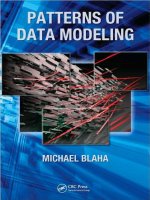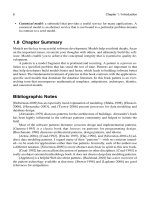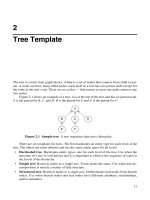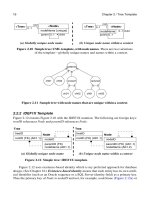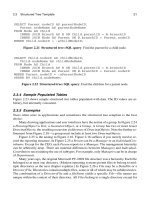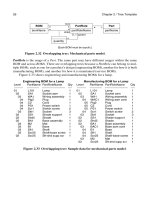PATTERNS OF DATA MODELING- P4 pdf
Bạn đang xem bản rút gọn của tài liệu. Xem và tải ngay bản đầy đủ của tài liệu tại đây (136.6 KB, 5 trang )
Contents xi
Part VI: Relational Database Design 203
Chapter 16 Relational Database Design 205
16.1 Mapping: Entity Types 205
16.2 Mapping: Non-Qualified Relationships 206
16.3 Mapping Qualified Relationships 208
16.4 Mapping: Generalizations 210
16.5 Design Identity 212
16.6 Referential Integrity 216
16.7 Miscellaneous Database Constraints 218
16.8 Indexes 220
16.9 Generating SQL Code 220
16.10 Chapter Summary 221
Bibliographic Notes 222
References 222
Appendix A Explanation of the UML Notation 223
Entity Type 223
Relationships 224
Generalization 227
Bibliographic Notes 227
References 228
Appendix B Explanation of the IDEF1X Notation 229
Entity Type 229
Relationships 230
Generalization 233
Bibliographic Notes 234
References 234
Appendix C Glossary 235
Index 241
xiii
Preface
I know there is a need for this book. I have been modeling application and enterprise data for
25 years now—the last 15 as a consultant to dozens of organizations. I’m often asked how I
conceive software models, and why I construct them a certain way.
Methodology books (including my own prior books) give an answer for beginners. They
present concepts, notation, and a simple process. This new book provides the next level of
techniques for building models, for those who have mastered the basics. When I build mod-
els, my thought processes revolve around patterns. This book provides detailed patterns as a
basis for more expertly building data models.
This book focuses on databases and not on programming, because most commercial
software is built around a database. The database representation (the data model) sets the
scope for the software, determines its flexibility, affects its quality, and influences whether
the software succeeds or fails.
This book can help readers avoid mistakes. I know that with tried and tested patterns I
could have avoided some of my past modeling mistakes.
This book can help readers build better models. I rifled through past consulting projects
and noted the improvements in my recent models. If this book had been available earlier in
my career, I could have had better models and built them more quickly.
Who Should Read This Book?
The new book has multiple audiences. It is targeted at practitioners but is also suitable for
advanced courses.
• Application architects. Application architects help determine the focus of an applica-
tion and drive that focus into the resulting software. They have to pin down the require-
ments, understand the requirements, determine what is in and out of scope, and set the
xiv Preface
key abstractions in the software. These tasks revolve around models and often data mod-
els. The skillful use of patterns is intrinsic to building quality models.
• Enterprise architects. These architects reach beyond a single application and address
the needs of an entire enterprise. The suite of applications for an enterprise must provide
the required business functionality and work well together. There is no better way to
harmonize applications than by modeling them in-depth and aligning the models. With
models, gaps become apparent and problems can be resolved.
• Data modelers. Experienced modelers will find the new book to be a helpful reference
for its concise and in-depth advice. Beginning modelers can use the new book as a re-
source for learning.
• Database administrators. In many organizations DBAs do more than just attend to the
day-to-day servicing of the database (backups, tuning, authorization, and so forth).
Many DBAs create data models and maintain the models as applications evolve.
• Programmers. Databases pervade commercial applications. Nevertheless, many pro-
grammers have trouble with databases and are tentative about how to apply them. This
book can help programmers represent their data, a mind-set that is essential for success-
ful use of databases.
• Courses. Many universities offer advanced, special-topics courses as part of their grad-
uate curriculum; this book could be used for such a course. The book is also suitable for
commercial data modeling courses.
What You Will Find
My usage of the term pattern is different than the literature but consistent with the spirit of
past work. I treat pattern as an overarching term encompassing mathematical templates, anti-
patterns, archetypes, identity, and canonical models.
Part I (Chapters 2–7) concerns mathematical templates, abstract data structures that lie
at the core of many application models. I use a deliberate style in presenting each template.
First I present UML and IDEF1X diagrams. Then I show representative queries, followed by
tables populated with sample data. Finally I present one or more examples using the tem-
plate. I explain the trade-offs for alternative templates. The discussion of each template is
mostly self contained; once you find an appropriate template you can understand it by read-
ing only a few pages.
Part II (Chapters 8–9) provides another perspective with antipatterns, characterizations
of common software flaws. When developers find an antipattern, they should substitute the
correction. The literature has antipatterns for programming code, but antipatterns also apply
to data models.
Part III (Chapter 10) covers archetypes, deep concepts that are prominent and cut across
applications. Developers should keep these concepts in mind as they construct models. The
use of an archetype can lead to a conceptual breakthrough. By necessity, my list is arbitrary
Preface xv
and incomplete. The models and explanation are also incomplete, so readers will need to add
detail as they include these concepts.
Part IV (Chapter 11) focuses on identity, that property of an entity that distinguishes
each entity from all others. Identity is a prominent concern in databases because developers
must have some way for finding and referring to things. This chapter emphasizes conceptual
aspects of identity and minimizes discussion of implementation.
Part V (Chapters 12–15) discusses several canonical models, submodels that often arise
during application modeling.
Part VI (Chapter 16) covers relational database design, how to take a UML model, pre-
pare a corresponding IDEF1X model, and then finally create SQL code.
Appendices A and B explain the UML and IDEF1X notations. Appendix C collects ma-
jor concepts from throughout the book and defines them.
Comparison with Other Books
Several existing books claim to cover data modeling patterns. They are informative books,
but their emphasis is on seed models and not patterns. A seed model is a starter model that
is specific to a particular application. In contrast, I define a pattern as a model fragment that
transcends individual applications. Some of the books have latent patterns, but they are im-
plicit and mingled with application content. All of the authors cited below use a different no-
tation.
•Martin Fowler. Analysis Patterns: Reusable Object Models. Boston, Massachusetts:
Addison-Wesley, 1997.
Fowler’s work is closest in spirit to this book. His is an excellent book but really
does not discuss patterns. Instead it presents seed models with occasional commentary
on the underlying patterns. Fowler presents models for various applications and evolves
the models as he gradually complicates the requirements. Oddly, Fowler uses a
database-oriented notation with object-oriented jargon.
• David C. Hay. Data Model Patterns: Conventions of Thought. New York: Dorset
House, 1996.
This is another excellent book, but it does not cover true patterns. Hay presents seed
models for many applications. Hay uses a database notation that is less concise than the
UML.
• Len Silverston. The Data Model Resource Book, Volumes 1 and 2. New York: Wiley,
2001.
This book is similar in style to Hay’s book, but covers a wider variety of applica-
tions. Silverston uses Richard Barker’s notation.
• Len Silverston and Paul Agnew. The Data Model Resource Book, Volume 3. New York:
Wiley, 2009.
xvi Preface
Volume 3 is more abstract than Silverston’s prior two volumes and has some deep
insights about patterns. This book is most pertinent to Chapter 10 on archetypes. Vol-
ume 3 continues to use Richard Barker’s notation.
• Jim Arlow and Ila Neustadt. Enterprise Patterns and MDA: Building Better Software
with Archetype Patterns and UML. Boston, Massachusetts: Addison-Wesley, 2004.
Most of Arlow and Neustadt’s book discusses seed models for several application
domains. They use the UML notation, but include programming-oriented aspects that I
omit.
Acknowledgments
I would like to thank the following reviewers of this book for their thoughtful and helpful
comments: Paul Brown, Donna Burbank, Peter Chang, Alex Ebel, Chary Gottumukkala,
Jack Hilty, Bill Huth, Steve Johnson, Patti Lee, Rod Sprattling, Joseph R. Stephen, Toby Teo-
rey, Sam Wegner, Rui Xu, and Roberto Zicari.
In particular I would like to thank Paul Brown for his deep insights. He caught several
errors, had many suggestions, and caused me to redouble my efforts to explain the patterns
clearly.
Of course, a book like this is not written in a vacuum. I also thank the many colleagues
and companies with whom I’ve worked and interacted over the years.
I used several tools in the writing of this book. Specifically, I used Enterprise Architect
to create the UML models and then rekeyed them with the Framemaker desktop publishing
software for a precise layout. I used ERwin CE to create IDEF1X models and also typeset
them with Framemaker. I tested the SQL code with Microsoft’s SQL Server.
Michael Blaha
Chesterfield, Missouri, USA
